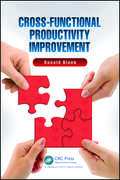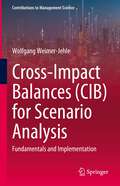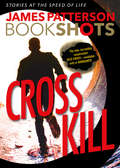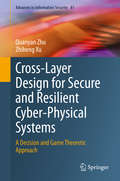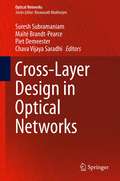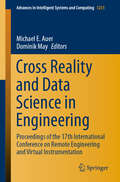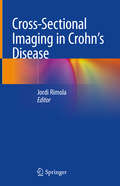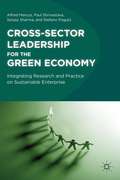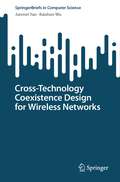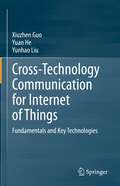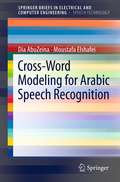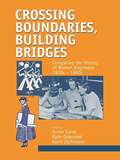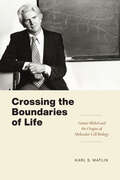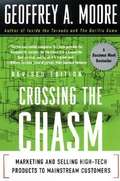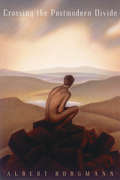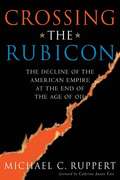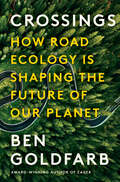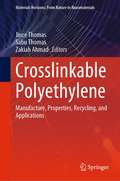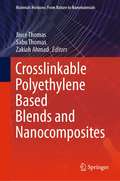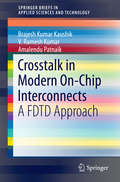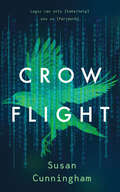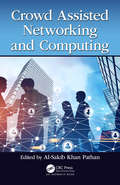- Table View
- List View
Cross-Functional Productivity Improvement
by Ronald BlankUsing language that is easy to understand, Cross-Functional Productivity Improvement describes how improvement efforts can be undermined by errors and incompleteness. It illustrates the various types of errors that can hurt productivity and outlines proven solutions to prevent or correct them. Explaining how departments not directly related to manufacturing can hinder productivity, it provides time-tested advice on how to reduce waste and enhance efficiency.The book starts with an overview of traditional productivity improvement methods. Subsequent chapters explain how different departments can affect productivity and describe what must be done to improve productivity. Supplying time-tested procedures for implementing cross-functional productivity actions that are applicable across a wide range of industries, the text describes the problems caused by incorrect Lean manufacturing, material flow, efficiency, ergonomics, quality policies, issues of malpractice, and counterproductive procedures. Includes many figures, illustrations, and tables that provide the technical information needed to implement sustainable productivity improvements Addresses the problems often caused by incorrect Lean manufacturing and issues of malpractice Includes an extensive glossary and a list of suggested readings to help readers further explore productivity improvement Readers will gain a clear understanding of exactly what to do and what not to do in all aspects of company operations to maximize productivity through a cross-functional approach. Furthermore, the book will enable companies to take better advantage of all that the ISO 9001 and similar systems have to offer by making best use of the interactions between the various elements of company operations.
Cross-Impact Balances: Fundamentals and Implementation (Contributions to Management Science)
by Wolfgang Weimer-JehleCross-Impact Balances (CIB) is a method frequently used for research, in companies and in administrations for the systematic construction of qualitative scenarios. This book introduces the fundamentals of the method and uses a clear step-by-step example to explain how scenarios can be constructed with CIB. It describes possible problems in applying the method and offers help for various use cases. It includes a detailed discussion of the design decisions that shape a CIB application and the methods that can be used to collect the necessary data. The application examples presented provide a first impression of the possibilities of the method. A discussion of the strengths and limitations of the method offers guidance on the use cases in which CIB can be profitably applied. The book is valuable for researchers and practitioners in the field of scenario analysis.
Cross Kill: An Alex Cross Story (An Alex Cross Story #1)
by James PattersonAlex Cross, I'm coming for you--even from the grave if I have to. Along Came a Spider killer Gary Soneji has been dead for over ten years. Alex Cross watched him die. But today, Cross saw him gun down his partner. Is Soneji alive? A ghost? Or something even more sinister? <P>Nothing will prepare you for the wicked truth. <P><b>A New York Times Bestseller</b>
Cross-Layer Design for Secure and Resilient Cyber-Physical Systems: A Decision and Game Theoretic Approach (Advances in Information Security #81)
by Quanyan Zhu Zhiheng XuThis book introduces a cross-layer design to achieve security and resilience for CPSs (Cyber-Physical Systems). The authors interconnect various technical tools and methods to capture the different properties between cyber and physical layers. Part II of this book bridges the gap between cryptography and control-theoretic tools. It develops a bespoke crypto-control framework to address security and resiliency in control and estimation problems where the outsourcing of computations is possible. Part III of this book bridges the gap between game theory and control theory and develops interdependent impact-aware security defense strategies and cyber-aware resilient control strategies.With the rapid development of smart cities, there is a growing need to integrate the physical systems, ranging from large-scale infrastructures to small embedded systems, with networked communications. The integration of the physical and cyber systems forms Cyber-Physical Systems (CPSs), enabling the use of digital information and control technologies to improve the monitoring, operation, and planning of the systems. Despite these advantages, they are vulnerable to cyber-physical attacks, which aim to damage the physical layer through the cyber network.This book also uses case studies from autonomous systems, communication-based train control systems, cyber manufacturing, and robotic systems to illustrate the proposed methodologies. These case studies aim to motivate readers to adopt a cross-layer system perspective toward security and resilience issues of large and complex systems and develop domain-specific solutions to address CPS challenges.A comprehensive suite of solutions to a broad range of technical challenges in secure and resilient control systems are described in this book (many of the findings in this book are useful to anyone working in cybersecurity). Researchers, professors, and advanced-level students working in computer science and engineering will find this book useful as a reference or secondary text. Industry professionals and military workers interested in cybersecurity will also want to purchase this book.
Cross-Layer Design in Optical Networks (Optical Networks #15)
by Chava Vijaya Saradhi Maïté Brandt-Pearce Suresh Subramaniam Piet DemeesterThis work addresses the topic of optical networks cross-layer design with a focus on physical-layer-impairment-aware design. Contributors captures both the physical-layer-aware network design as well as the latest advances in service-layer-aware network design. Treatment of topics such as, optical transmissions which are prone to signal impairments, dense packing of wavelengths, dispersion, crosstalk, etc., as well as how to design the network to mitigate such impairments, are all covered.
Cross Reality and Data Science in Engineering: Proceedings of the 17th International Conference on Remote Engineering and Virtual Instrumentation (Advances in Intelligent Systems and Computing #1231)
by Michael E Auer Dominik MayToday, online technologies are at the core of most fields of engineering and society as a whole . This book discusses the fundamentals, applications and lessons learned in the field of online and remote engineering, virtual instrumentation, and other related technologies like Cross Reality, Data Science & Big Data, Internet of Things & Industrial Internet of Things, Industry 4.0, Cyber Security, and M2M & Smart Objects.Since the first Remote Engineering and Virtual Instrumentation (REV) conference in 2004, the event has focused on the use of the Internet for engineering tasks, as well as the related opportunities and challenges. In a globally connected world, interest in online collaboration, teleworking, remote services, and other digital working environments is rapidly increasing. In this context, the REV conferences discuss fundamentals, applications and experiences in the field of Online and Remote Engineering as well as Virtual Instrumentation. Furthermore, the conferences focus on guidelines and new concepts for engineering education in higher and vocational education institutions, including emerging technologies in learning, MOOCs & MOOLs, and open resources.This book presents the proceedings of REV2020 on “Cross Reality and Data Science in Engineering” which was held as the 17th in series of annual events. It was organized in cooperation with the Engineering Education Transformations Institute and the Georgia Informatics Institutes for Research and Education and was held at the College of Engineering at the University of Georgia in Athens (GA), USA, from February 26 to 28, 2020.
Cross-Sectional Imaging in Crohn’s Disease
by Jordi RimolaThis book comprehensively describes the state of the art in cross-sectional imaging of Crohn’s disease from both a clinical and a radiological perspective. The uses and impact of the different imaging techniques in daily practice and research are thoroughly examined, with coverage of ultrasound, computed tomography and magnetic resonance. In addition, emerging trends are scrutinized. The background to the book is an increasing perception that intestinal inflammation and complications are underdiagnosed using standard endoscopic or surgical techniques. Patients with Crohn’s disease usually require multiple reassessments during their lifetimes and often favor noninvasive techniques with a low risk of complications. These factors have reinforced the need for effective cross-sectional imaging techniques. Additionally, the expanding use of biologic agents, combined with their increased efficacy, expense, and risk, justifies the use of these techniques (particularly ultrasound and magnetic resonance) to monitor disease treatment and objectively measure inflammation and healing. Cross-Sectional Imaging in Crohn’s Disease will be of high value for both gastroenterologists and diagnostic radiologists.
Cross-Sector Leadership for the Green Economy
by Alfred Marcus Paul Shrivastava Sanjay Sharma Stefano PogutzTechnology breakthroughs in sustainable renewable energy and energy conservation technologies require that there be a strong institutional ecosystem in place which supports innovation, but the nature of this foundation and how it works is not well-known. Becoming a leader necessitates new forms of cross-sector cooperation.
Cross-Technology Coexistence Design for Wireless Networks (SpringerBriefs in Computer Science)
by Junmei Yao Kaishun WuThis book introduces readers to the fundamentals of the cross-technology coexistence problem in heterogeneous wireless networks. It also highlights a range of mechanisms designed to combat this problem and improve network performance, including protocol design, theoretical analysis, and experimental evaluation.In turn, the book proposes three mechanisms that can be combined to combat the cross-technology coexistence problem and improve network performance. First, the authors present a fast signal identification method. It provides the basis for the subsequent protocol design and allows heterogeneous devices to adopt proper transmission strategies. Second, the authors present two cross-technology interference management mechanisms in both the time domain and the frequency domain, which can mitigate interference and increase transmission opportunities for heterogeneous devices, thus improving network performance. Third, they present a cross-technology communication mechanism based on symbol-level energy modulation, which allows heterogeneous devices to transmit information directly without a gateway, improving transmission efficiency and paving the way for new applications in IoT scenarios. Lastly, they outline several potential research directions to further improve the efficiency of cross-technology coexistence. This book is intended for researchers, computer scientists, and engineers who are interested in the research areas of wireless networking, wireless communication, mobile computing, and Internet of Things. Advanced-level students studying these topics will benefit from the book as well.
Cross-Technology Communication for Internet of Things: Fundamentals and Key Technologies
by Xiuzhen Guo Yuan He Yunhao LiuCross-technology communication (CTC) is a technology that enables direct communication between heterogeneous devices that use different wireless standards. It works like a “translator” between two or more wireless technologies. CTC not only creates a new avenue for inter-operation and data exchange between wireless devices but also enhances the ability to manage wireless networks. This book focuses on the enabling technology CTC and introduces readers to a variety of CTC techniques in heterogeneous wireless networks. These techniques can be divided into two categories: packet-level CTCs based on energy modulation and channel intervention; and physical-level CTCs based on cross-demapping, digital emulation, and split encoding. The book offers a comprehensive comparison and analysis, granting readers a deeper understanding of CTC techniques in terms of throughput, reliability, hardware modification, and concurrency. Moreover, it highlights upper-layer CTC application scenarios and cutting-edge developments, which include but are not limited to interference management, channel quality estimation, network routing, etc. The book is intended for all readers – e.g., researchers, students, and even professionals – who are interested in the areas of wireless networking, wireless communication, mobile computing, and Internet of Things. The findings and summaries presented here can help: 1) guide researchers to rethink CTC techniques in connection with design methodology; 2) further advance the infrastructure of future IoT by introducing CTC; and 3) enable important IoT applications by delivering ubiquitous network connectivity.
Cross-Word Modeling for Arabic Speech Recognition (SpringerBriefs in Speech Technology)
by Dia Abuzeina Moustafa ElshafeiCross-Word Modeling for Arabic Speech Recognition utilizes phonological rules in order to model the cross-word problem, a merging of adjacent words in speech caused by continuous speech, to enhance the performance of continuous speech recognition systems. The author aims to provide an understanding of the cross-word problem and how it can be avoided, specifically focusing on Arabic phonology using an HHM-based classifier.
Crossing Boundaries, Building Bridges (Routledge Studies in the History of Science, Technology and Medicine #Vol. 12)
by Annie Canel Ruth OldenzielWomen engineers have been in the public limelight for decades, yet we have surprisingly little historically grounded understanding of the patterns of employment and education of women in this field. Most studies are either policy papers or limited to statistical analyses. Moreover, the scant historical research so far available emphasizes the individual, single and unique character of those women working in engineering, often using anecdotal evidence but ignoring larger issues like the patterns of the labour market and educational institutions.Crossing Boundaries, Building Bridges offers answers to the question why women engineers have required special permits to pass through the male guarded gates of engineering and examines how they have managed this. It explores the differences and similarities between women engineers in nine countries from a gender point of view. Through case studies the book considers the mechanisms of exclusion and inclusion of women engineers.
Crossing the Boundaries of Life: Günter Blobel and the Origins of Molecular Cell Biology (Convening Science: Discovery at the Marine Biological Laboratory)
by Karl S. MatlinA close look at Günter Blobel’s transformative contributions to molecular cell biology. The difficulty of reconciling chemical mechanisms with the functions of whole living systems has plagued biologists since the development of cell theory in the nineteenth century. As Karl S. Matlin argues in Crossing the Boundaries of Life, it is no coincidence that this longstanding knot of scientific inquiry was loosened most meaningfully by the work of a cell biologist, the Nobel laureate Günter Blobel. In 1975, using an experimental setup that did not contain any cells at all, Blobel was able to target newly made proteins to cell membrane vesicles, enabling him to theorize how proteins in the cell distribute spatially, an idea he called the signal hypothesis. Over the next twenty years, Blobel and other scientists were able to dissect this mechanism into its precise molecular details. For elaborating his signal concept into a process he termed membrane topogenesis—the idea that each protein in the cell is synthesized with an "address" that directs the protein to its correct destination within the cell—Blobel was awarded the Nobel Prize in Physiology or Medicine in 1999. Matlin argues that Blobel’s investigative strategy and its subsequent application addressed a fundamental unresolved dilemma that had bedeviled biology from its very beginning—the relationship between structure and function—allowing biology to achieve mechanistic molecular explanations of biological phenomena. Crossing the Boundaries of Life thus uses Blobel’s research and life story to shed light on the importance of cell biology for twentieth-century science, illustrating how it propelled the development of adjacent disciplines like biochemistry and molecular biology.
Crossing the Boundaries of Life: Günter Blobel and the Origins of Molecular Cell Biology (Convening Science: Discovery at the Marine Biological Laboratory)
by Karl S. MatlinA close look at Günter Blobel’s transformative contributions to molecular cell biology. The difficulty of reconciling chemical mechanisms with the functions of whole living systems has plagued biologists since the development of cell theory in the nineteenth century. As Karl S. Matlin argues in Crossing the Boundaries of Life, it is no coincidence that this longstanding knot of scientific inquiry was loosened most meaningfully by the work of a cell biologist, the Nobel laureate Günter Blobel. In 1975, using an experimental setup that did not contain any cells at all, Blobel was able to target newly made proteins to cell membrane vesicles, enabling him to theorize how proteins in the cell distribute spatially, an idea he called the signal hypothesis. Over the next twenty years, Blobel and other scientists were able to dissect this mechanism into its precise molecular details. For elaborating his signal concept into a process he termed membrane topogenesis—the idea that each protein in the cell is synthesized with an "address" that directs the protein to its correct destination within the cell—Blobel was awarded the Nobel Prize in Physiology or Medicine in 1999. Matlin argues that Blobel’s investigative strategy and its subsequent application addressed a fundamental unresolved dilemma that had bedeviled biology from its very beginning—the relationship between structure and function—allowing biology to achieve mechanistic molecular explanations of biological phenomena. Crossing the Boundaries of Life thus uses Blobel’s research and life story to shed light on the importance of cell biology for twentieth-century science, illustrating how it propelled the development of adjacent disciplines like biochemistry and molecular biology.
Crossing the Boundaries of Life: Günter Blobel and the Origins of Molecular Cell Biology (Convening Science: Discovery at the Marine Biological Laboratory)
by Karl S. MatlinA close look at Günter Blobel’s transformative contributions to molecular cell biology. The difficulty of reconciling chemical mechanisms with the functions of whole living systems has plagued biologists since the development of cell theory in the nineteenth century. As Karl S. Matlin argues in Crossing the Boundaries of Life, it is no coincidence that this longstanding knot of scientific inquiry was loosened most meaningfully by the work of a cell biologist, the Nobel laureate Günter Blobel. In 1975, using an experimental setup that did not contain any cells at all, Blobel was able to target newly made proteins to cell membrane vesicles, enabling him to theorize how proteins in the cell distribute spatially, an idea he called the signal hypothesis. Over the next twenty years, Blobel and other scientists were able to dissect this mechanism into its precise molecular details. For elaborating his signal concept into a process he termed membrane topogenesis—the idea that each protein in the cell is synthesized with an "address" that directs the protein to its correct destination within the cell—Blobel was awarded the Nobel Prize in Physiology or Medicine in 1999. Matlin argues that Blobel’s investigative strategy and its subsequent application addressed a fundamental unresolved dilemma that had bedeviled biology from its very beginning—the relationship between structure and function—allowing biology to achieve mechanistic molecular explanations of biological phenomena. Crossing the Boundaries of Life thus uses Blobel’s research and life story to shed light on the importance of cell biology for twentieth-century science, illustrating how it propelled the development of adjacent disciplines like biochemistry and molecular biology.
Crossing the Chasm: Marketing and Selling Disruptive Products to Mainstream Customers
by Geoffrey A. MooreHere is the bestselling guide that created a new game plan for marketing in high-tech industries. Crossing the Chasm has become the bible for bringing cutting-edge products to progressively larger markets. It provides new insights into the realities of high-tech marketing, with special emphasis on the Internet. It's essential reading for anyone with a stake in the world's most exciting marketplace.
Crossing the Digital Divide: Applying Technology to the Global Refugee Crisis
by Culbertson Dimarogonas Costello LannaAmid a growing global forced displacement crisis, refugees and the organizations that assist them have turned to technology as an important resource in solving problems in humanitarian settings. This report analyzes technology uses, needs, and gaps, as well as opportunities for better using technology to help displaced people and improving the operations of responding agencies.
Crossing the Postmodern Divide
by Albert BorgmannIn this eloquent guide to the meanings of the postmodern era, Albert Borgmann charts the options before us as we seek alternatives to the joyless and artificial culture of consumption. Borgmann connects the fundamental ideas driving his understanding of society's ills to every sphere of contemporary social life, and goes beyond the language of postmodern discourse to offer a powerfully articulated vision of what this new era, at its best, has in store. This] thoughtful book is the first remotely realistic map out of the post modern labyrinth. OCoJoseph Coates, "The Chicago Tribune" Rather astoundingly large-minded vision of the nature of humanity, civilization and science. OCo"Kirkus Reviews""
Crossing the Rubicon
by Michael C RuppertThe Rubicon signifies a point of no return. Peak Oil and 9/11 are two such points that signal so profound a change in the course of world events that no one will remain unaffected. The attacks of September 11, 2001 were accomplished through an amazing orchestration of logistics and personnel. Crossing the Rubicon discovers and identifies key suspects - finding some of them in the highest echelons of American government - by showing how they acted in concert to guarantee that the attacks produced the desired result. A superbly detailed scrutiny of the events of 9/11, the book also ranges across the terrain of rapidly diminishing hydrocarbon energy supplies, geopolitics, narco-traffic, intelligence and militarism - without which 9/11 cannot be understood. Crafted as a criminal investigation of a homicide, Crossing the Rubicon examines: * the motives for the 9/11 attacks, including the Pentagon's need for a pretext for war that would enable an all-out drive for the planet's last reserves of oil and gas; Wall Street's need for liquid cash from restored traffic in Afghani heroin; and the administration's need for legal domestic repression during severe and imminent resource shortages; * the personnel, including Dick Cheney, the Pakistani Intelligence Agency (ISI), the Taliban, al Qaeda, the bin Ladens and elements of the government of Saudi Arabia: * the intelligence, including covert software, the full complexity of the US intelligence community, the connections with Wall Street and the Israeli government; * the carefully designed opportunity on the day of the attacks, the role of the Secret Service and the US Vice President: * the coverup; and * the outcome: "The War on Terror" as pretext for the loss of US civil liberties and domination of world oil reserves. ...at the end of three years of conducting a really independent investigation, Ruppert is not only heading in the right direction, but also touching the inner sanctum of the hidden government agenda. --Andreas von Bulow, former German Cabinet Minister & Parliamentary Secretary MICHAEL RUPPERT is the Publisher/Editor of From the Wilderness, a newsletter read by more than 16,000 subscribers in 40 countries. A former LAPD narcotics investigator, he is widely known for his groundbreaking stories on US involvement in the drug trade, Peak Oil and 9/11.
Crossings: How Road Ecology Is Shaping the Future of Our Planet
by Ben GoldfarbShortlisted for the NYPL's 2024 Helen Bernstein Book Award for Excellence in Journalism A New York Times Notable Book of 2023 and an Editors' Choice • A Science News Favorite Book of 2023 • A Kirkus Reviews Best Nonfiction Book of 2023 • A Smithsonian Staff Favorite of 2023 • A New Yorker Best Book of 2023 • A Booklist Top 10 Book on the Environment & Sustainability for 2024 An eye-opening account of the global ecological transformations wrought by roads, from the award-winning author of Eager. Some 40 million miles of roadways encircle the earth, yet we tend to regard them only as infrastructure for human convenience. While roads are so ubiquitous they’re practically invisible to us, wild animals experience them as entirely alien forces of death and disruption. In Crossings, environmental journalist Ben Goldfarb travels throughout the United States and around the world to investigate how roads have transformed our planet. A million animals are killed by cars each day in the U.S. alone, but as the new science of road ecology shows, the harms of highways extend far beyond roadkill. Creatures from antelope to salmon are losing their ability to migrate in search of food and mates; invasive plants hitch rides in tire treads; road salt contaminates lakes and rivers; and the very noise of traffic chases songbirds from vast swaths of habitat. Yet road ecologists are also seeking to blunt the destruction through innovative solutions. Goldfarb meets with conservationists building bridges for California’s mountain lions and tunnels for English toads, engineers deconstructing the labyrinth of logging roads that web national forests, animal rehabbers caring for Tasmania’s car-orphaned wallabies, and community organizers working to undo the havoc highways have wreaked upon American cities. Today, as our planet’s road network continues to grow exponentially, the science of road ecology has become increasingly vital. Written with passion and curiosity, Crossings is a sweeping, spirited, and timely investigation into how humans have altered the natural world—and how we can create a better future for all living beings.
Crosslinkable Polyethylene: Manufacture, Properties, Recycling, and Applications (Materials Horizons: From Nature to Nanomaterials)
by Jince Thomas Sabu Thomas Zakiah AhmadThis volume covers various aspects of cross-linked polyethylene (XLPE). The contents include manufacture, morphology, structure, properties, applications, early stage development, cross-linking techniques, recycling process, physical and chemical properties as well as the scope and future aspects of XLPE. It focuses on the life cycle analysis of XLPE and their industrial applications and commercial importance. This book will be of use to academic and industry researchers, as well as graduate students working in the fields of polymer science and engineering, materials science, and chemical engineering.
Crosslinkable Polyethylene Based Blends and Nanocomposites (Materials Horizons: From Nature to Nanomaterials)
by Jince Thomas Sabu Thomas Zakiah AhmadThis volume serves as a cutting edge reference on XLPE based blends, nanocomposites, and their applications. The book provides an introduction to XLPE nanocomposites and discusses the incorporation of natural and inorganic nanoparticles in the XLPE matrix. It also focuses on its characterization as well as the morphological, rheological, mechanical, viscoelastic, thermal, and electrical, properties. It provides an in-depth review of various potential applications, with special emphasis on use in cable insulation. The book focuses on cutting edge research developments, looking at published papers, patents, and production data. This book will be of use to academic and industry researchers, as well as graduate students working in the fields of polymer science and engineering, materials science, and chemical engineering.
Crosstalk in Modern On-Chip Interconnects: A FDTD Approach (SpringerBriefs in Applied Sciences and Technology)
by Brajesh Kumar Kaushik V. Ramesh Kumar Amalendu PatnaikThe book provides accurate FDTDmodels for on-chip interconnects, covering most recent advancements inmaterials and design. Furthermore, depending on the geometry and physicalconfigurations, different electrical equivalent models for CNT and GNR basedinterconnects are presented. Based on the electrical equivalent models theperformance comparison among the Cu, CNT and GNR-based interconnects are alsodiscussed in the book. The proposed models are validated with the HSPICEsimulations. The book introduces the currentresearch scenario in the modeling of on-chip interconnects. It presents thestructure, properties, and characteristics of graphene based on-chipinterconnects and the FDTD modeling of Cu based on-chip interconnects. Themodel considers the non-linear effects of CMOS driver as well as thetransmission line effects of interconnect line that includes couplingcapacitance and mutual inductance effects. In a more realistic manner, theproposed model includes the effect of width-dependent MFP of the MLGNR whiletaking into account the edge roughness.
Crow Flight
by Susan CunninghamThe curious flight patterns of crows lead a teen computer programmer down a path of mystery and romance.Gin trusts logic a little too much. She even designs programs to decide what to eat and how to spend her time. All that changes when she's paired with a new transfer student, Felix, on a computer modeling assignment to explain certain anomalies in the behavior of crows.Speaking of anomalies, why is Gin so disappointed that Felix isn't a match for her in the dating app she's designing with local gamers?As she enters Felix's world and digs further into the data behind crow behavior, Gin uncovers a terrible secret. And the wrong decision could equal disaster squared...
Crowd Assisted Networking and Computing
by Al-Sakib Khan PathanCrowd computing, crowdsourcing, crowd-associated network (CrAN), crowd-assisted sensing are some examples of crowd-based concepts that harness the power of people on the web or connected via web-like infrastructure to do tasks that are often difficult for individual users or computers to do alone. This creates many challenging issues like assessing reliability and correctness of crowd generated information, delivery of data and information via crowd, middleware for supporting crowdsourcing and crowd computing tasks, crowd associated networking and its security, Quality of Information (QoI) issues, etc. This book compiles the latest advances in the relevant fields.
